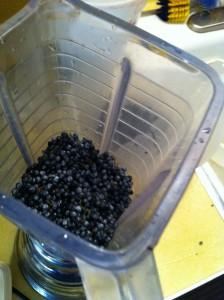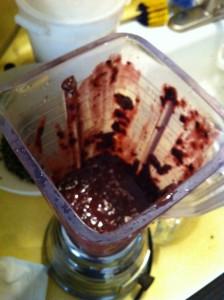
Got Elderberry?
NOTE: I’m republishing this post from July , 2013, as the timing for it is perfect right now. Elderberries can still be found closer to the coast than the Ojai Valley or in cooler microclimates inland.
Fresh Elderberry juice is one of Nature’s most delicious rewards for our foraging efforts. Elderberry harvesting season is here now; in fact, for those of us in the inland valleys of Southern California it’s already been here and gone due to the drought-like conditions this year. Last week, though, I managed to find a couple of trees loaded with ripe berries in the Upper Ojai Valley. Your best bet now is to look closer to the coast or along creeks and rivers that empty into the ocean where you’ll find there are still plenty around.
WARNING: All parts of the Elderberry plant are toxic except for the flowers and ripe fruits. Like all Elderberry trees, our local species, Sambucus nigra ssp. caerulea, also known as Blue Elderberry, contains hydrocyanic acid and sambucine, a poisonous alkaloid. These are concentrated in the woody parts, seeds, stems, and leaves and can cause symptoms closely resembling symptoms of intoxication, nausea, intestinal issues, and possible cardiac arrest. Some people experience nausea or diarrhea from ingesting the raw berries but, most likely, the seeds are the culprits. According to the USDA and others, the ripe berries are edible but many sources recommend using only cooked or dried berries. Personally, I have no problem eating a few raw fruits or drinking the fresh juice made from deseeded berries in moderation but I recommend starting with small amounts or cooking the berries until you know your tolerance. Drying them in the sun or in a dehydrator will also make the fruit safe to eat but you’ll still have all those pesky seeds inside. (Some people report digestive issues with Red Elderberry, which does not grow in Southern California, so I do not recommend using it without first testing a small amount on yourself.)
Elderberry trees and shrubs are drought-tolerant but they prefer to grow near water sources where there is some moisture in the air and a high water table. They like the coastal influence and can often be found in the valleys surrounding streams on their way to the ocean. Some of them in those cooler climates still have flowers.
The upright umbels of yellow flowers we see from early spring on into early summer give way to green berries from late spring on.

By the time the berries are purple-ripe in early-to-mid-summer, they hang in heavy clusters covered with a whitish bloom. Though one tree may have clusters at different stages of ripeness, the berries in each cluster will ripen at about the same time. As mentioned above, this ripening window can vary from place to place and even from tree to tree in the same area.
Elderberries grow in temperate zones around the globe and are enjoyed by many cultures, each with their own recipes and harvesting/processing methods. Many wonderful products can be made from them, the most popular being wine, pies and jellies. For medicinal use, they are prepared as a tincture, extract or syrup. There are many recipes available for you to explore. I make fresh juice from them that can be used as a base for most end products except the pie. Here is how I do it.
To collect berries I look for a healthy tree in an unpolluted location where it is permissible to harvest. I climb a ladder and use hand pruning clippers to snip off each cluster at its main stem, then gently place them in a bucket held in a shoulder bag. 
Back on the ground, I transfer them from the bucket to cardboard berry flats lined with paper to keep them from falling through as they are much smaller than other commercial berries. I use the green plastic strawberry baskets for easier handling and to help support the weight of the berries in the flats but they are not necessary. You can just carry them home in the bucket if you don’t mind bruising a few.
There is, however, some essential equipment needed for my method once you get them home: a blender or food processor, a jelly strainer bag, a dark-colored apron and an assortment of bowls, colanders and strainers. Gloves are recommended for straining. No denying, this is a labor-intensive process but not complicated if you have the right stuff. Most of the time can be spent in removing the tiny berries from their tiny stems. One easy shortcut is to put the bunches of fresh-picked berries in a paper bag or laid out on trays in the freezer overnight. Then, shaking the bag or rolling them around in your hands will cause most of the berries to snap right off the stems. The trade-off is that the berries will become very soft when they thaw out so they must be processed right away or put back in the freezer for later use. I prefer to process them fresh but it’s work!
First step (or next step if you froze and de-stemmed them first) is to fill a medium-sized bowl with clusters of berries (or de-stemmed berries if you froze them first) and cover them with water. Pour off what floats to the surface. Repeat this step to wash out bugs, premature berries, leaves, dust, etc. Then transfer to a colander and use a dinner fork to pull them off the stems, inserting it into the ends of the clusters and pulling out through the berries. This works remarkably well.
 Next, a final wash for the de-stemmed berries and back to the colander to drain any excess water.
Next, a final wash for the de-stemmed berries and back to the colander to drain any excess water.
The second phase is to pulp the berries in a blender or food processor. I think 2 cups at a time is a good amount to work with.  Just a quick whiz until the mass becomes liquid is all that is needed.
Just a quick whiz until the mass becomes liquid is all that is needed.
 Next, pour the pulp into a jelly strainer bag and squeeze out the rich, blood-red juice.
Next, pour the pulp into a jelly strainer bag and squeeze out the rich, blood-red juice. 
You won’t be able to squeeze out the last drops from this mushy mass and that’s okay because at that point you might be extracting the astringent or toxic parts from the stems and seeds. Note the green color of the bag compared to the pulp just strained through it.
The 2 cups of berries you put in the blender should yield 1 cup of juice.
I like to drink it just like that, 2 to 4 ounces at a time, either straight or mixed with club soda or ginger ale. To me, it has a pomegranate-boysenberry flavor with a mild astringency like that of fresh pomegranate. To make a delicious sweet beverage, mix the juice with roughly an equal part simple syrup or just sweeten to your taste preference. My wife Rondia made sherbet with it in a gelato machine by adding simple syrup and evaporated milk. She is one of those who doesn’t care for its unique wild flavor as-is but I love it!
Elderberry is considered a medicinal nutrient, containing high amounts of Vitamin C and anti-viral properties. The berries contain sugars, the amino acid tyrosine, malates of potash and lime, and malic and tartaric acids which have an alkalinizing and cleansing effect in the body. In addition to Vitamin C, they are rich in Vitamin A, calcium, phosphorous, and potassium. There are traces of protein, riboflavin, niacin, and iron. They have 72 calories per 100 grams of berries. According to Dr. James Adams and Cecilia Garcia, “Sambucol, a standardized Sambucus nigra extract, is available in the U.S. and has been shown in clinical trials to decrease the duration of the flu by 3 to 4 days. Sambucol appears to increase the immune response against viral infections, even HIV.”
Resources:
Healing with Medicinal Plants of the West by Cecilia Garcia and James D. Adams, Jr.
Edible and Useful Plants of California by Charlotte Bringle Clarke
Nature’s Garden by Samuel Thayer
“The Benefits of the Use of Elder in Herbal Preparations” by Carol Bond
“Local Superfoods: Elderberry and Chokecherry” at the Living Wild Project website






Great read Lanny! We have a large tree in our back yard which I have pruned into a tree. I have not yet tried the berries but enjoy seeing the birds consume them. We have two other trees that I am working to emulate the backyard one. Also I am trying to grow some from seeds and may be successful soon. Got some 4 inch plants growing in pots. Thanks for these posts! I and Vicki are have a great time in our retirement.
Steve
Hey, you’re welcome, Steve. Thanks for commenting. Nice to know someone is reading them. Yes, even if you never eat them yourself, they are great for attracting birds. According to Charlotte Bringle in her book referenced at the end of my post, “The elderberry is an important source of summer food for many songbirds such as the Western Bluebird, House Finch, Red-Shafted Flicker, Ash-throated Flycatcher, Black-headed Grosbeak, Scrub and Steller’s Jays, Ruby -crowned Kinglet, Bullock’s and Hooded Oriole, and Phainopepla.”
thank you for the thorough discourse. Got to say my disappointment was steep when we waited for the elderberries to get on their full purple color before picking just to learn each and everyone had been digested by the birds.
This is such a great resource teach thanks again.
I think I will throw a net over the fig tree since we have so many more than usual they will be a fast game for squirrels.
Hi Kate. Please see list of birds that like Elderberry in my reply to Steve Lopez’s post. Good thing is even if you can’t harvest your own Elderberry tree, there are plenty growing wild, unlike your figs. The net sounds like a good idea. Another option to try is shiny stuff hanging in the tree (Christmas tinsel, old CD’s, etc.) or a rubber/inflatable snake or two wrapped around a branch. Thanks for sharing!
would love to know where in Los Angeles elderberry can be found, I’ve been looking out but so far no luck
Elderberry trees can be found throughout the coastal sage scrub and riparian plant communities all over Southern California. Google photos of Samubucus nigra subspecies caerulea and then start watching for the umbels of yellow flowers. It’s harder to spot now before it flowers. Also, please read my blog post on Sustainable Foraging before collecting any flowers or berries.
Where can I have elderberries sent to me in Oklahoma? I want to start making syrup and gummy bears for my tea.
Black elderberry (Sambucus nigra) grows all over the U.S., including Oklahoma. This page will help you get started finding it: https://plants.usda.gov/core/profile?symbol=SANI4. In the meantime, I’m sure you can buy dried elderberries online. I don’t sell them or know anyone around here who does. Better yet, plant a tree if you have the space. Here’s a page from Oklahoma State University about growing them: https://extension.okstate.edu/fact-sheets/growing-elderberries-in-oklahoma.html. Good luck and thanks for checking in.
Hi, do you sell fresh already harvested elderberries?
No, I don’t but I lead herb walks and workshops and show people how to identify, harvest and prepare them.
So glad I found you. I was wondering if there are elder flower is blooming right now? I would like to make some cordial, and I don’t know where to find any or if they would grow in Ventura. Thanks so much!
Hi Anna. Elderberries are found throughout Ventura County. Most are not blooming yet but there is always one here or there that is on its own timetable. You can find lots of websites to help identify them on my RESOURCES page. Best way to learn, though, is to come on an herb walk or nature hike with me.
As always, your posts are timely and informative. Thanks for this outstanding one!
Thanks, Julie. Come join us again for an herb walk. It’s been a while.